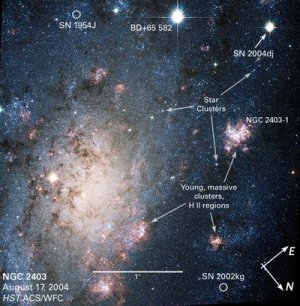Long-standing Supernova Mystery Solved

Professors Roberta Humphreys and Kris Davidson and graduate student Michael Gordon in the School of Physics and Astronomy and their collaborator Schuyler Van Dyk at Caltech have solved the 63-year-old mystery of a supernova that wasn’t.
In 1954, a star in a nearby spiral galaxy NGC 2403, brightened by about 100 times. It was considered a supernova, the explosion, and annihilation of a giant star, and was named SN 1954J. Its eruption lasted about a year before it faded. But SN1954J was peculiar.
For several years before the giant eruption, it had shown rapid and erratic fluctuations in brightness. At its maximum light in 1954, it was not as luminous as a true supernova. Today these objects are called supernova impostors. These eruptions initially look like supernovae, but they are less luminous and the star survives. A recent Hubble Space Telescope image showed that the object identified with SN1954J was actually four stars. One with strong hydrogen emission, typical of stars that have lost mass, was the likely survivor. But there was a problem. This star is now more than 10 times fainter than the star that had the eruption.
After a giant eruption, a star is expected to recover temperature and pressure equilibrium in a few years. Astronomers wondered why this star hadn’t recovered after all this time. It was expected to return to close to its original brightness. Some theorized that it had been a true supernova all along and that astronomers were now seeing a different star, others thought it was an imposter with the surviving star obscured by a dust cloud. The biggest problem was with the standard dust model in which the extinction varies with the wavelength. It could not explain the star’s radiation and spectrum at different wavelengths.
When a second spectrograph was installed on the Large Binocular Telescope’s second mirror, Humphreys realized that she might be able to get some more clues to the mystery. “I realized I could get twice the light using both mirrors, so 90 minutes of exposure effectively became 3 hours.” This gave her a much better spectrum of the hydrogen emission line which was coming from a hot star losing mass, but she found something unexpected: absorption lines, which are an indication of a cool star. With this new evidence, she concluded that star four, the supposed survivor, was actually two stars.Humphreys explains that both stars were suffering about the same amount of extinction or dimming by circumstellar dust. The extinction of the blue and the far-red was about the same. It was therefore neutral and did not depend on wavelength. This was peculiar but not entirely unknown. It meant that the dust grains had to be large. Large dust grains have been observed in one other supernova imposter: the famous Eta Carinae, often considered the prototypical impostor. Supernova impostor giant eruptions are dusty and it may be that they all produce large grains. So SN1954J is actually two stars, the hotter star, the progenitor and survivor of the eruption is probably a 20 solar mass star, much lower than expected for a giant eruption supernova impostor. Its neighbor is a slightly lower mass, much cooler star. It is not known if they are a physical pair.